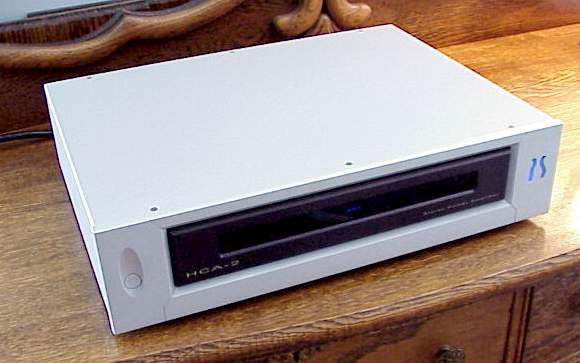Product Review - PS Audio HCA-2
Solid State Digital Switching Two-Channel Power Amplifier - June, 2002
John E. Johnson, Jr.
![]()
|
|
Specifications: Power Output: 150 Watts RMS per Channel x 2 Into 8 Ohms, 225 Watts RMS per Channel into 4 Ohms; 275 Watts RMS per Channel into 2 Ohms MFR: 10 Hz - 20 kHz ± 0.5 dB THD: 0.5% Input Impedance: 100 kOhms Input Sensitivity: 1.15 Volts Size: 4 1/2" H x 17" W x 14" D Weight: 35 Pounds MSRP: $1,695 |
|
PS Audio; http://www.psaudio.com |
Introduction
Digital switching amplifiers have been around for a number of years, and they are especially popular for use with subwoofers. The reason for this is that it is expensive to design and build one that works well throughout the audible spectrum (20Hz - 20 kHz), but inexpensive switching amps work fine in the low frequencies, where subwoofers operate. They run cool and are small in size. So, subwoofers everywhere are using them.
Only a handful of designers have been building top notch full range switching amplifiers. Even though they don't necessarily have a chassis full of parts, they have been high in price. This is partly because they don't have much competition, but also, it is very tough to have them switch at really high frequencies, and it is the high switching frequency that allows a good sound reproduction at the top end of the audible spectrum.
The HCA-2
Over the past few years, Paul McGowan, of PS Audio, has gained international renown for his development of products that deliver clean AC. The voltage coming out of our wall sockets is full of noise, not only harmonics of the 60 Hz, but motor noise from our refrigerators and other household appliances, along with that of our neighbors who are on the same supply circuits. There have been lots of products developed that filter out some of the noise, but none that completely eliminate it. That is, none, until PS Audio introduced the Power Plant P300. Later came the P600 and the P1200, the latter of which I use here in our lab. It converts the incoming AC to DC, then starts over with a completely clean 60 Hz regeneration from that DC. It is big, heavy, and expensive, but boy does it work.
With that fundamental experience in designing power supplies, Paul decided to go into power amplifiers, where the power supply continues to be critical.
The HCA-2 is PS Audio's first digital switching power amplifier. It delivers 150 watts x 2 into 8 Ohms and 225 into 4 Ohms. It is referred to as Class D (for the digital switching), with two gain stages (input and output, with a buffer in between), and uses very little negative feedback.
As you may remember, most amplifiers are Class A/B. This means that there is a small amount of current running through the output stage (Class A) even when no music is playing, and at low levels of sound, this current goes to the speaker instead of being dissipated as heat. At higher sound levels, the current has to be turned on (Class B). Depending on how much of the power is in Class A vs. Class B, the amp can run hotter at idle than when the music is playing loud.
Class D amplifiers, like the HCA-2, have no current running in the output stage at idle, like a Class B stage. However, they differ from Class B in that, when the music comes through, the output stage is switched on and off (Class D), rather than current running continuously during the music (Class B). The HCA-2 input stage runs in pure Class A. The output stage is where the switching is applied.
The trick is to switch the current on and off so fast that you hear it as being continuous, like the 60 fields per second on our TVs being fast enough that we see it as continuous motion. In order to have this work properly, and sound good, you need a switching frequency of 10 times the highest frequency that you are listening to (not an industry definition, just the opinion of some, including me). So, assuming an average human ear hearing up to 20 kHz, you would need a switching frequency of 200 kHz minimum. The big bucks switching amplifiers of the recent past use frequencies sufficiently high to achieve this. Some amps use less than the minimum, and they sound good, but not great. The HCA-2 uses a switching frequency of 500 kHz, which more than meets the standard, and yet the price is modest. How did he do it? Well, the technology has matured, it is available, and somebody had to be first. That is Paul McGowan.
The Look
The HCA-2 is a very modern-looking product. An aluminum faceplate with inconspicuous on/off switch, an LED panel, and the PS Audio Logo, are all that you see. It is lightweight and will fit anywhere. Although it runs cool, I put it on an open shelf just to be safe. You should do the same. Don't invite trouble.
The rear panel has gold-plated RCA input jacks, XLR input jacks (the HCA-2 is a fully balanced amplifier), and very high quality gold-plated five-way speaker binding posts.
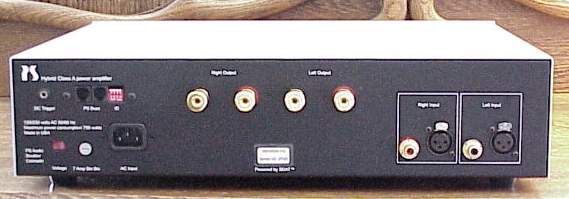
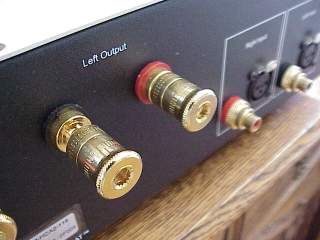
On the left side of the rear panel are the grounded AC socket (balanced designs must use this, and it is important that you don't connect any of the speaker terminals to ground), along with two RJ45 jacks for use with connecting the HCA-2 to other components (PS Audio calls it the PS Buss). Dip switches allow you to customize the communications configuration. There is also a 12 Volt DC trigger jack for automatically turning on the HCA-2 when you turn on your preamplifier.
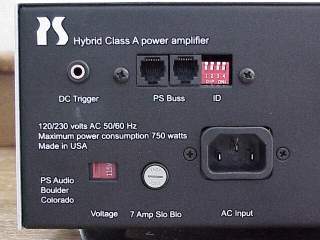
The Sound
Ah, this is the best part. Finally, a digital switching amplifier, affordable by all, that sounds terrific. I tested the HCA-2 with a Sony SACD player, Balanced Audio Technology VK-5i preamplifier, Magneplanar MG 1.6 Speakers, Threshold ES-500 Full Range Electrostatic Speakers, and Nordost Cables.
Because I was used to hearing an edgy sound in some previous digital switching amps, I was sort of expecting the HCA-2 to be not all that much different. Maybe a little improvement. However, I was very surprised to hear it sound much like my Balanced Audio Technology VK-75SE triode power amplifier (which is several times the price I might add). One reason for this is that both amps use only two gain stages and none to very little negative feedback. However, triodes are supposed to sound a lot different than solid state. So, even with the gain stages and negative feedback similarities, they should still sound different because one is tube and the other solid state, shouldn't they? Well, I am not entirely sure why they sounded the same (and the word is "fabulous" if I haven't mentioned it already), but I suspect it is because tubes were designed for audio, and transistors were originally designed for switching, but transistor amplifiers have been trying to do what tubes were doing, until now (bipolar transistors were, however, specifically designed for audio purposes). The HCA-2 uses transistors for what they were originally designed, namely as switching devices. Instead of using transistors to replace tubes, digital switching amplifiers use transistors as transistors. Hello . . . it works!
The sound is satin smooth. Warm and fuzzy, I suppose is an appropriate description (as in a warm and fuzzy cat on your lap by the fire). Now that is not to say all tube amplifiers and well-designed solid state switching amplifiers are going to sound that way. There are poor quality tube amps as well as Class A/B solid state amps, and there will be lousy digital switching amplifiers in the future, even though the technology is now easier to build than it used to be. Mass market products will surely make use of digital switching amplifiers, but it is unlikely they will sound like an HCA-2, because parts quality still raises a cost issue. However, they will sound much better than they used to.
Typically, a balanced amplifier has a bit more difficulty driving a low impedance load, because the act of balancing makes the amplifier "think" it is seeing a 4 Ohm load when actually using an 8 Ohm load. But, the HCA-2 is so efficient, it is rated into a full 2 Ohms. I tested this idea by using the HCA-2 with planar speakers, which are a difficult load for amplifiers.
Measuring the frequency response, I found that it is really not very flat. In fact, there is a peak at 50 kHz. The overall response is flatter using the XLR inputs compared to the unbalanced RCA inputs (graphs shown below), particularly in the deep bass region. The peak is one of the things that can happen when you don't use negative feedback. In fact, flattening the response is a major reason negative feedback is used. A high frequency peak like this one at 50 kHz can result in parasitic oscillation that occurs with loads (speakers and cables) that have significant reactive impedance. This is another reason I wanted to use the HCA-2 with planar speakers, which are notoriously reactive loads. However, the HCA-2 performed flawlessly. A big power transformer in the HCA-2 may be the reason. They can handle reactive load problems. Once we see digital switching amplifiers in mass market receivers, reactive load speakers will be an issue, because I doubt they will use big power transformers due to the cost. The HCA-2 played the DTS music disc of Holst "The Planets" (Telarc CD-80466), having no difficulties through the full range electrostatic speakers. The sound remained crystal clear, and I could see the panels shimmering from the low frequencies. It may be awhile before mass market digital switching amplifiers can deal with "Mars, The Bringer of War" on that disc.
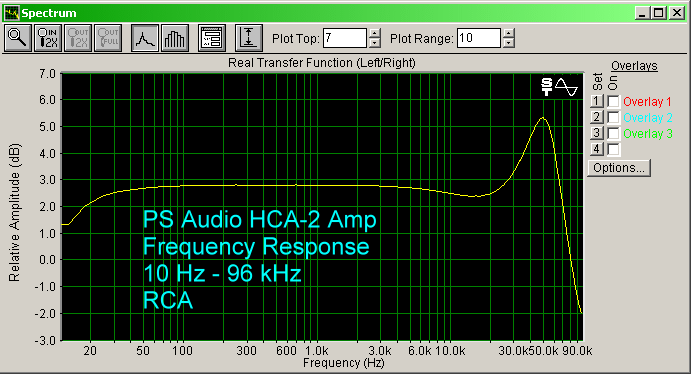
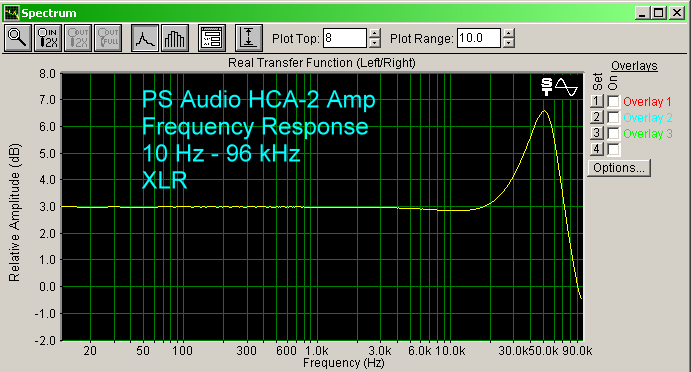
Harmonic distortion spectra, shown below, indicate a higher than average amount of distortion. Again, this is typical of low-negative feedback amplifiers. A second function of negative feedback is to lower the total amount of distortion. That is why mass market receivers have low distortion specifications. Lots of negative feedback. The problem is that, when negative feedback is overused, it increases the amount of higher-order odd-ordered distortion (7th and 9th for example), which gives a harsh sound. That type of use has given negative feedback a bad name. Proper use gives detail to the sound a bit more edge, but not irritating. The HCA-2 has the detail, but it is not as noticeable. Amplifiers that use proper amounts of negative feedback have the same amount of detail, but it is a little more forward, more noticeable. It all depends on design goals and personal sound preferences of the consumer. I tend to like the warm and fuzzy sound of tubes, and of something like the HCA-2. The use of negative feedback reduces the gain, so amplifiers with negative feedback tend to have more gain stages. The HCA-2 doesn't use much negative feedback, so only two gain stages are necessary.
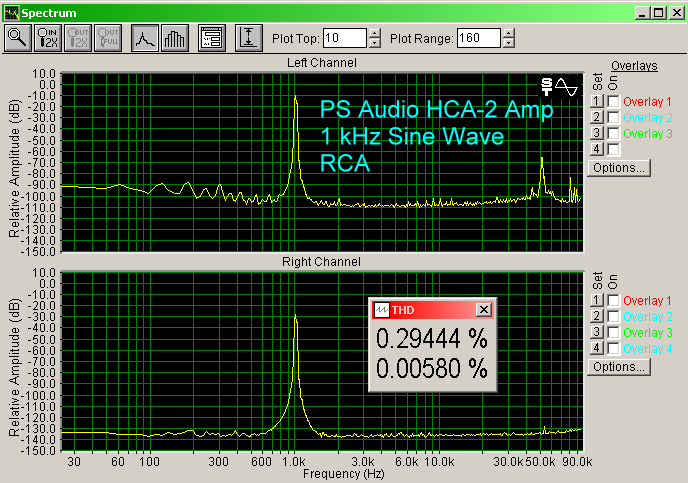
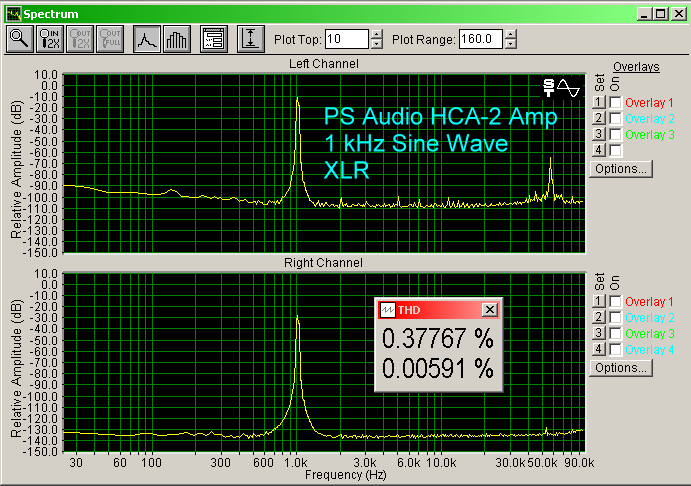
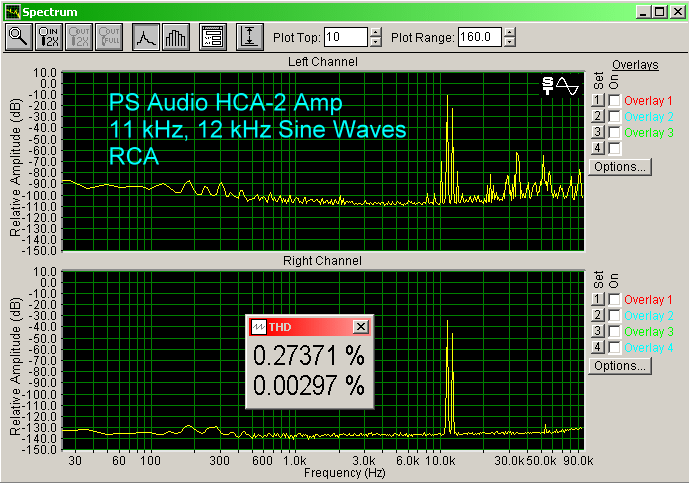
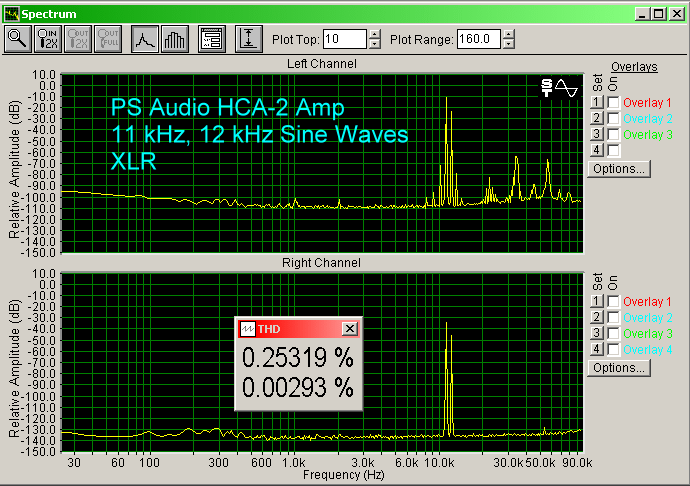
You might think that the sound stage and directionality of such an amplifier could be attenuated compared to something with more accentuated detail, but that was not the case with the HCA-2. For example, with the SACD "Triangulo" (Telarc SACD-63549), the drums are recorded with multiple microphones spread left to right. During certain riffs, the drummer goes along each of the tom toms, and I could see them follow across the stage perfectly. There was no gap in the middle. Plenty of detail. Plenty of staging.
The violin is a tough instrument to reproduce. It is complex, with plenty of high frequency harmonics. Berlioz' "Symphonie Fantastique" (Telarc SACD-60578) has lots of violins, and I could hear the rosin from across the room.
Now, of course, SACD makes any amplifier sound better, but our old antique technology CDs are still worth keeping. One of my favorite recent discs is "In Tone Nation", where Yuko Maruyama plays a Shigeru Kawai piano. It is a phenomenal recording, and I enjoyed it just as much with the HCA-2 as I do with my BAT VK-75SE. That is saying quite a bit actually.
The HCA-2 has a modest noise floor, as shown below. It is about the same with the RCA input or the XLR input (XLR a few dB lower), and about 30 dB above the control shown in the pass through right channel. Interestingly, each input had different noise peaks from the other. I could hear a soft background noise, like someone exhaling through their mouth, when I put my ear up to the tweeter. But, moving even just a foot away from the speaker, I could not hear it.
Because the HCA-2 is a digital switcher at 500 kHz, some of the clock noise may be getting through to the output. If so, the sound card we use for the analysis, being 24/192, will not be able to analyze the 500 kHz noise correctly, and it might show up as the noise peaks around 50 kHz as indicated below. This is because D to A and A to D only works properly up to half the sampling frequency, which for our equipment, is 96 kHz analog (half the 192 kHz digital sampling frequency). These peaks, then, could partly explain the 50 kHz peak in the frequency response. Regardless of where the noise peaks come from, they are not in the audible band, and the HCA-2 is within 0.5 dB from 20 Hz to 20 kHz using the RCA input, and within 0.25 dB using the XLR input.
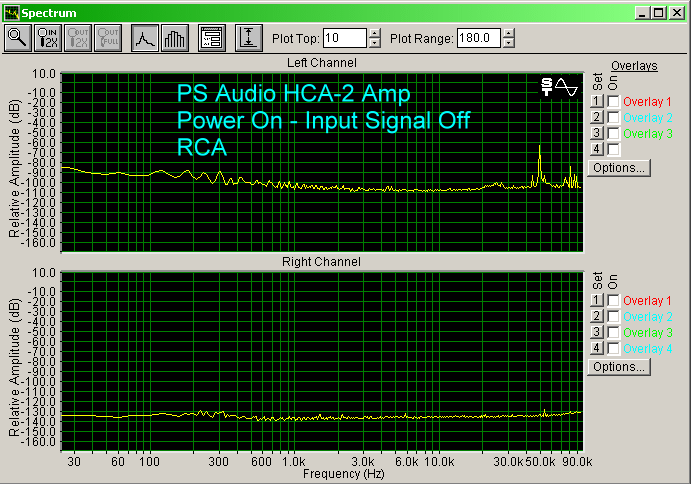
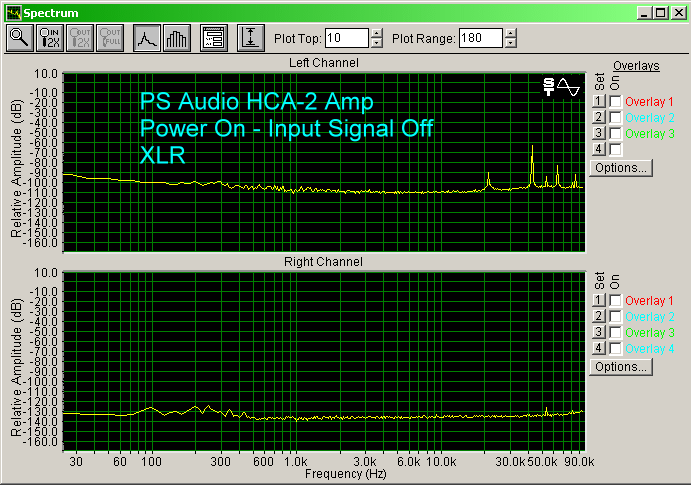
Just to make sure this noise floor was not a result of the speaker cable, I turned the amplifier off and took a spectrum with the input signal being applied. The graph is shown below. The noise floor is the same as the pass through on the right channel (output of sound card connected to the input).
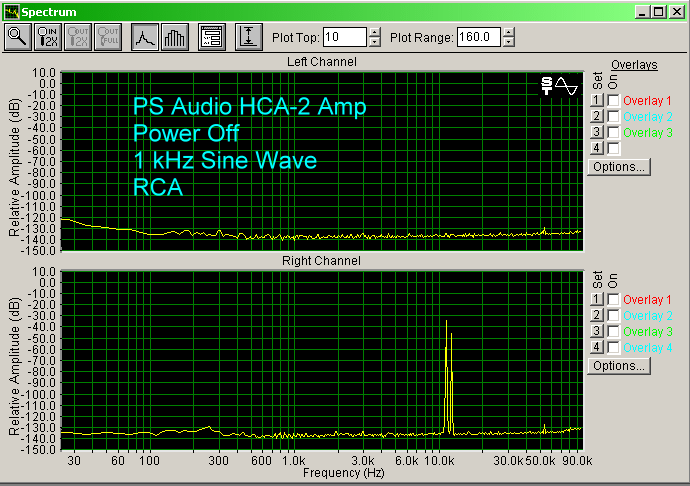
Conclusion
Digital switching amplifiers are now affordable by all. The PS Audio HCA-2 is first on the scene with a top notch design that will fit on your Mastercharge or Visa without being rejected. It has the sound of a fine tube amplifier, but without all the heat, and certainly with more power. It seemed capable of driving tough speakers. I cannot recommend it more highly.
- John E. Johnson, Jr. -
PS Audio Responds:
The HCA-2 is a LOW-feedback design, not a NO negative feedback design. In
addition, though, that negative-feedback loop includes the output filter
network that's required in all switching amps. This is an area where we have
improved on traditional Class-D designs: By including the output filter in the
NFB loop, we minimize the tendency for the ultrasonic frequency response to
vary widely with load. That's not to say that we eliminate such load-induced
variations, but you'll find that we're quite a bit better here than older
designs. I have juggled things in such a way that I accept a bit of "bump" to
minimize the "bumpiness" with different speakers. In addition, the "bump" in
the ultrasonic response does not, per se, occur as a result of the application
of feedback itself, as it would with a conventional linear amp. Therefore, the
amp is 100% stable even into a fully-reactive load like an electrostatic
loudspeaker system.
In addition, electrostatic loudspeakers, even with their highly reactive load
impedance, are in fact no more difficult for our amp to drive than a load
resistor! This has nothing to do with the power supply, as it would
with a conventional AB amp, but a lot to do with Class-D operation itself.
With a conventional amp, secondary-breakdown limitations in the output
transistors can destroy the output stage or force the manufacturer to
utilize protection circuitry that can impact the amp's sound. In Class-D
operation, load current is load current, and it doesn't matter whether the
load is resistive or reactive.
And feel free to pile books and records (of course) on top of the amp. If you were to monitor the amp while playing full tilt, the output transistors would be barely warm to the touch. In fact, the warmest thing inside the box is the power transformer just sitting there idling.
John Levreault
PS Audio
![]()
©
Copyright 2002 Secrets of Home Theater & High Fidelity
Return to Table
of Contents for this Issue.

